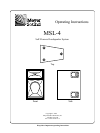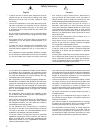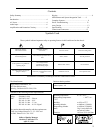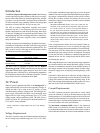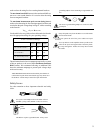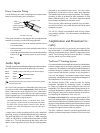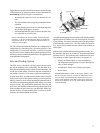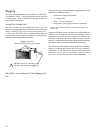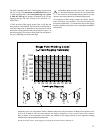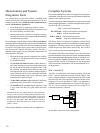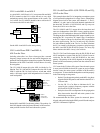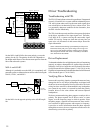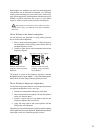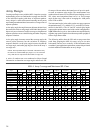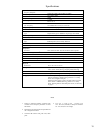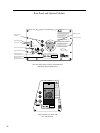
4
Introduction
The MSL-4 self-powered loudspeaker system is ideal for large
venues requiring long throw distances and precise coverage,
but can also be used effectively in smaller applications. Its high-
Q (narrow coverage) horn has a consistent beam width across
its entire frequency range, enabling efficient array design that
maximizes coverage and SPL for a given array size.
The MSL-4 contains independent amplifier and control
electronics for one 12” low frequency cone driver (in a horn-
loaded vented enclosure) and one high frequency horn driver
(2” throat, 4” diaphragm) in a compact trapezoidal cabinet. This
integrated design provides excellent performance, durability,
and reliability, eliminates amplifier racks, and simplifies
setup and installation.
The MSL-4 matches well with the Meyer Sound DS-4 self-pow-
ered mid/bass loudspeaker, the PSW-2 and 650-P self-powered
subwoofers, and also performs efficiently with the PSW-4. The
MSL-4 can be used as a full-range or mid-hi speaker and has
the following acoustical specifications:
Frequency Response ±4 dB 65 Hz – 18 kHz
Phase Response ±30° 450 Hz – 10 kHz
Coverage 40° H x 35° V
Dynamic Range > 110 dB
The MSL-4 can be equipped to operate with the Remote
Monitoring System™ (RMS) interface network and software
application. RMS displays signal and power levels, driver and
cooling fan status, limiter activity, and amplifier temperature
for all speakers in the network on a Windows-based PC. Contact
Meyer Sound for more information about RMS.
AC Power
When AC power is applied to the MSL-4, the Intelligent AC™
supply automatically selects the correct operating voltage, al-
lowing the MSL-4 to be used in the US, Europe, or Japan
without manually setting a voltage switch. The Intelligent AC
power supply also protects the MSL-4 by performing surge
suppression for high voltage transients (up to 275V), min-
imizing inrush current, and filtering EMI. The MSL-4 uses a
NEMA L6-20P or IEC 309 male power inlet and satisfies UL,
CSA, and EC safety standards.
NOTE: Continuous voltages higher than 275V may damage
the unit!
Voltage Requirements
The MSL-4 operates safely and without audio discontinuity if
the AC voltage stays within the ranges 85–134V or 165–264V,
at 50 or 60Hz. Immediately after applying AC power, the green
Active LED on the user panel illuminates and the proper operat-
ing voltage is automatically selected, but the system is muted.
During the next three seconds, the primary fan turns on, the
main power supply slowly ramps on, and the system is enabled
to pass audio signals.
TROUBLESHOOTING NOTE: If the Active LED does not
illuminate or the system does not respond to audio input after
ten seconds, remove AC power to avoid possible damage to
the unit. Experienced electronics technicians with access to a
test bench can verify proper operation for the power supply and
amplifier system with The Meyer Sound Self-Powered Series MP-2
and MP-4 Field Verification Procedure (part # 17.022.066.01;
contact Meyer Sound to receive this document). All other users
should contact Meyer Sound or an authorized Meyer Sound
service center.
If the voltage decreases below the lower bound of either op-
erating range (known as a brown-out period), the supply uses
current from its storage circuits and continues to function briefly.
The unit turns off if the voltage does not increase above the
threshold before the storage circuits are depleted. The length
of time that the MSL-4 continues to operate during brown-out
depends on how low the voltage drops and the audio source
level during this period.
If the voltage fluctuates within either operating range, automatic
tap selection stabilizes the internal operating voltage. This tap
selection is instantaneous and there are no audible artifacts. If
the voltage increases above the upper bound of either range,
the power supply turns off rapidly, preventing damage to the
unit.
If the MSL-4 shuts down due to either low or high voltage, the
power supply automatically turns on after three seconds if the
voltage has returned to either normal operating range. If the
MSL-4 does not turn back on after ten seconds, remove AC power
and refer to the TROUBLESHOOTING NOTE above.
Current Requirements
The MSL-4 presents a dynamic load to the AC mains which
causes the amount of current to fluctuate between quiet and
loud operating levels. Since different types of cables and circuit
breakers heat up (and trip) at varying rates, it is essential to un-
derstand the types of current ratings and how they correspond
to circuit breaker and cable specifications.
The maximum continuous RMS current is the maximum
RMS current over a duration of at least 10 seconds. It is used
to calculate the temperature increase in cables, which is used to
select cables that conform to electrical code standards. It is also



